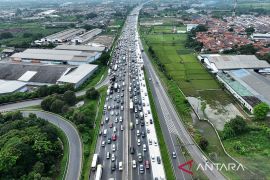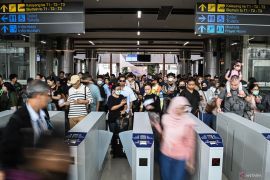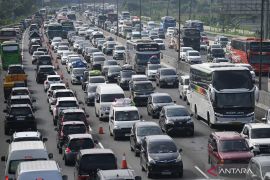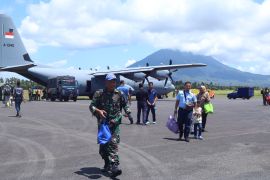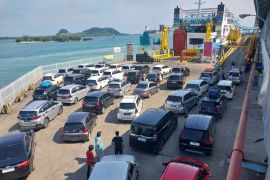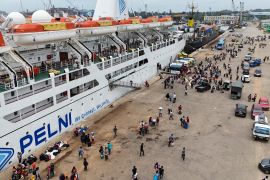The Jakarta-Cikampek section of the Trans-Java Toll road, for example, takes about eight to nine hours to be covered. On normal days, this section can be covered in two to three hours.Jakarta (ANTARA News) - Home coming of Eid al-Fitr, or Lebaran travelers, notably those using Trans-Java Toll Roads in Java began to peak Friday, two days (H-2) before the Lebaran D-Day on Sunday.
Tens of thousands of private cars and other vehicles used by travelers poured into both toll and non-toll roads retarding the traffic flow.
The Jakarta-Cikampek section of the Trans-Java Toll road, for example, takes about eight to nine hours to be covered. On normal days, this section can be covered in two to three hours.
Toll road operators earlier predicted that the Lebaran traveler exodus would peak on Friday (June 23) and on Saturday.
The Jakarta-Cipali (Jakarta-Cikampek-Palimanan) toll road section has relatively been packed with vehicles on Friday. "It took me 12 hours to drive my car from Jakarta to Palimanan. I left Jakarta at 2 a.m on Friday and arrived at Palimantan at 2 p.m. I used to cover this route in five or six hours only," said Amrurrahman, who traveled to Cirebon, West Java, to celebrate the post fasting festivities there.
According to National Police Chief General Tito Karnavian, the Eid al-Fitri traveler exodus would peak on Friday (June 23) and Saturday (June 24).
"The homecoming flow of travelers will peak on Friday, but we predict that it will continue on Saturday," Karnavian said.
He noted that the traffic density as seen on Friday would mean the flow would be relatively smooth and safe. "The traffic density intensified since H-4, and it will last until H-2, so the H-1 day will see relatively smoother flow," the police chief remarked.
The current traffic condition is different from that during last years Lebaran homecoming season, where the worst traffic jams took place.
"The worst gridlock occurred at the Brebes (toll) Exit (Brexit) during the Eid al-Fitr travelers exodus last year. However, it will not happen this homecoming season," Karnavian emphasized.
He revealed that to avoid the recurrence of traffic jam, an emergency toll road had been put into operation, and a flyover had been built in the Pejagan area.
The worst gridlock took place during the exodus on the Pejagan-Pemalang toll road in Java last year, because the construction of the turnpikes had not finished then.
The main point of the traffic jam was the Brebes toll exit (Brexit), as the remaining section of the toll road was not yet finished.
"A gridlock took place four days before the Eid al-Fitr D-Day (H-4) last year. Now, there will be no (traffic jam)," the police chief asserted, when observing the Grinsing emergency toll road in Batang, Central Java.
Based on the monitoring of the toll lanes from Jakarta until Grinsing toll exit in Batang, the flow of traffic was relatively dense but smooth.
"Density occurred only at the rest area in Palimanan, where vehicle queues extended up to 500 meters, because residents who wanted to say Friday prayers passed by the area," he observed.
Regarding the conditions at the Brexit toll lane, the flow of Lebaran travelers on H-2 was relatively quiet. Small vehicles which were heading from the Ciapli toll section went ahead to enter the emergency toll road (new toll road operated temporarily).
At the same time, Minister of Transportation Budi Karya Sumadi also observed the flow of Eid travelers on several toll roads, non-toll roads and bridges prone to traffic congestion.
Journalists who joined the minister in Cirebon reported that Sumadi had monitored the road sections in Palimanan, Cisomang Bridge, Purbaleunyi, and Cipularang from aboard a helicopter that took off from the Halim Perdana Kusuma Airport, Jakarta.
The transportation minister conducted the review to ensure a safe, smooth, and comfortable journey for travelers on the homecoming route and to immediately address any shortcomings.
On Thursday, travelers thronged the Cipularang and Purbaleunyi toll roads, connecting Cikampek and Cileunyi, West Java. The distance from Jakarta to Cikampek, which usually takes two to three hours, was covered in eight to nine hours on Thursday.
"I left Jakarta at 8 a.m. local time, but I reached Cikampek only at 4:30 p.m. local time on Thursday," Iskandar, a traveler, who used his own car to head to Semarang in Central Java, said at Rest Area Kilometer (km) 57.
The Jakarta-Cikampek toll road is part of the Trans-Java toll road.
He revealed it took longer to cover the distance owing to the heavy flow of traffic on the toll road.
Heavy traffic was reported Thursday night, or three days before Eid al-Fitr, at several sections of the Jakarta-Cikampek toll road. Vehicles can only reach speeds of about 5km to 10km per hour.
"The highest speed at which we could drive our vehicles was about 20km to 30km per hour," he added.
Based on Antaras observation, Thursday afternoon, the density of traffic on the Purbaleunyi toll road began to increase at the 154-km mark, or near the Cileunyi toll gate leading to Nagreg.
Traffic density was dominated by private cars and buses, especially those headed to Garut, Tasikmalaya, as well as cities in southern Central Java.
Meanwhile, traffic congestion also occurred on the Jakarta-Cikampek toll road due to accidents that occurred Thursday morning.
Heavy traffic was also witnessed around the entrance to the rest area at some locations.
Several parking bay facilities located at the 18-, 41-, and 58-km mark on the Jakarta-Cikampek toll road are not being used by travelers.
According to information, several rest areas on the Jakarta-Cikampek toll road are offering special facilities to serve the travelers, including health posts and e-money sales outlets.
The Jakarta-Cikampek Toll Road operator imposed a contraflow policy at two points of the turnpikes to ease traffic congestion Friday morning.
"We applied the contraflow system, starting at 9:25 a.m. local time, between the 14- to 21-km mark and from the 32- to 41-km mark," Handoyo, spokesman of the state-owned operator PT Jasa Marga for the Jakarta-Cikampek Toll Road, noted.
According to Handoyo, the number of vehicles on the Jakarta-Cikampek toll road that leads to Pantura in the northern area of Java and Bandung in West Java continued to witness an increase since Thursday night through Friday.
"Traffic congestion can be observed between the 32- and 41-km mark. Congestion has also been reported from GT Cikarang Utama to the 36-km mark," he mentioned.
It is now imposing the contraflow system from the 32- to 41-km mark to ease vehicle density at the 36-km mark, also ahead of the rest area at the 39-km mark.
"The traffic will thereafter be diverted again in the second contraflow at the section from the 13-km to 21-km mark," he revealed.(*)
Reporter: Andi Abdussalam
Editor: Heru Purwanto
Copyright © ANTARA 2017
